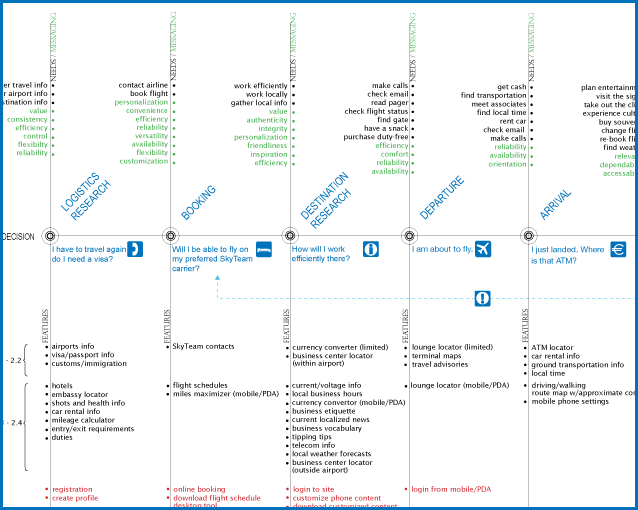
In a recent Harvard Business Review (HBR) article, the writer makes the case for the creation of Customer Journey Maps in an organization.
In many large companies journey maps are created at the inception of every project but are seldom followed through, and when they are they tend to be treated as final and not iterative. In other instances journey maps are created in specific areas of the business with teams working diligently to make every customer touchpoint as effective as possible. The writer also makes the argument that while an organization must measure each touchpoint, it would be a mistake to declare individual touchpoints a success when the journey as a whole is under-performing.
The practice of building Personas (or Personae) is at the core of a well performing business. Businesses that perform best are the ones that understand their customers thus offering an enjoyable experience whether shopping, booking a flight, renting a car, searching for information or being social. The process of creating a customer journey map displays how a persona interacts with the brand. Each one of the identified activities are then explored in detail and features are assigned to improve the experience or completely revamp it. The end product is one or more diagrams that clearly describe the activities or touchpoints, associated features and corresponding emotional state of the persona.
In our day to day work, while working on the projects we have been assigned to, we clearly strive to make each touchpoint of the customer journey a success so we can deliver an overall successful experience. But we are really building micro journeys. A micro journey is a project specific customer journey that, if performed well, will make for a successful project for the business segment that commissioned the work. In this case we are delivering a specific experience that applies to a subset of the larger picture. It is important to resolve the problem/need/want that was presented to us. But are we missing the real opportunity? Shouldn’t we have a clear idea, an understanding of what comes before and after? Has our project become one of the touchpoints or one of its activities within the larger customer journey?
The answer is most likely yes to all of the above. No one likes to ask the client any more than is absolutely necessary, even though I have never met a client that didn’t care about the success of their project. There is a significant upside to asking the right question while you are still working on a solution. The results may vary greatly, other projects could be impacted and new ones may stem from it.
As CX leads it is critical to push the boundaries of an ideated solution, and visibility into the macro journey maps are what brings us closer to better define the micro journey that we have to deliver on.
Since more and more organizations are struggling to understand the way their customers are reaching them, adopting customer journey is a clear signal of the transition organizations are undertaking. The focus is slowly shifting from an organization centric view to a customer centric view. While this is nothing new for the majority of customers, large organizations have been slow to adopt it, in part for lack of data to support micro journeys. Macro journeys structured around the product lifecycle have been easy to define and are supported by data readily available in the various areas of the business, however the focus has been product-centric. The institution of micro journeys are pushing the various lines of business to switch from a product to a customer centric view and journeys are popping up in all areas of the company. The two main difficulties implementing micro journeys lie in the lack of the overarching Macro journey and by a lack of real data to support them.
In order for a company to successfully adopt this method it has to create an overarching macro customer journey, which in an agile environment may be viewed as an epic. The touchpoints defined in an epic journey will be further broken down and assigned to the various lines of business (LOBs). The LOBs will then breakdown the touch points into their own journeys. If necessary the LOB created journey maps can be further broken down. Only at this point a project that satisfies one or more activities on a journey may be undertaken.
The discoveries made during the journey mapping exercises may not be simple to execute or easy to correct without top level support and well established communication guidelines. Essentially a customer journey mapping exercise allows for all levels within the company to work together and create a validated and executable company strategy. And in one swoop it provides a clear directive to the entire company.

[…] RT @mbgorman: Insightful “macro vs micro customer journey” by Giovanni Fortezza http://t.co/ggHxELI8Hd #CX #agileba #agilepm #baot […]